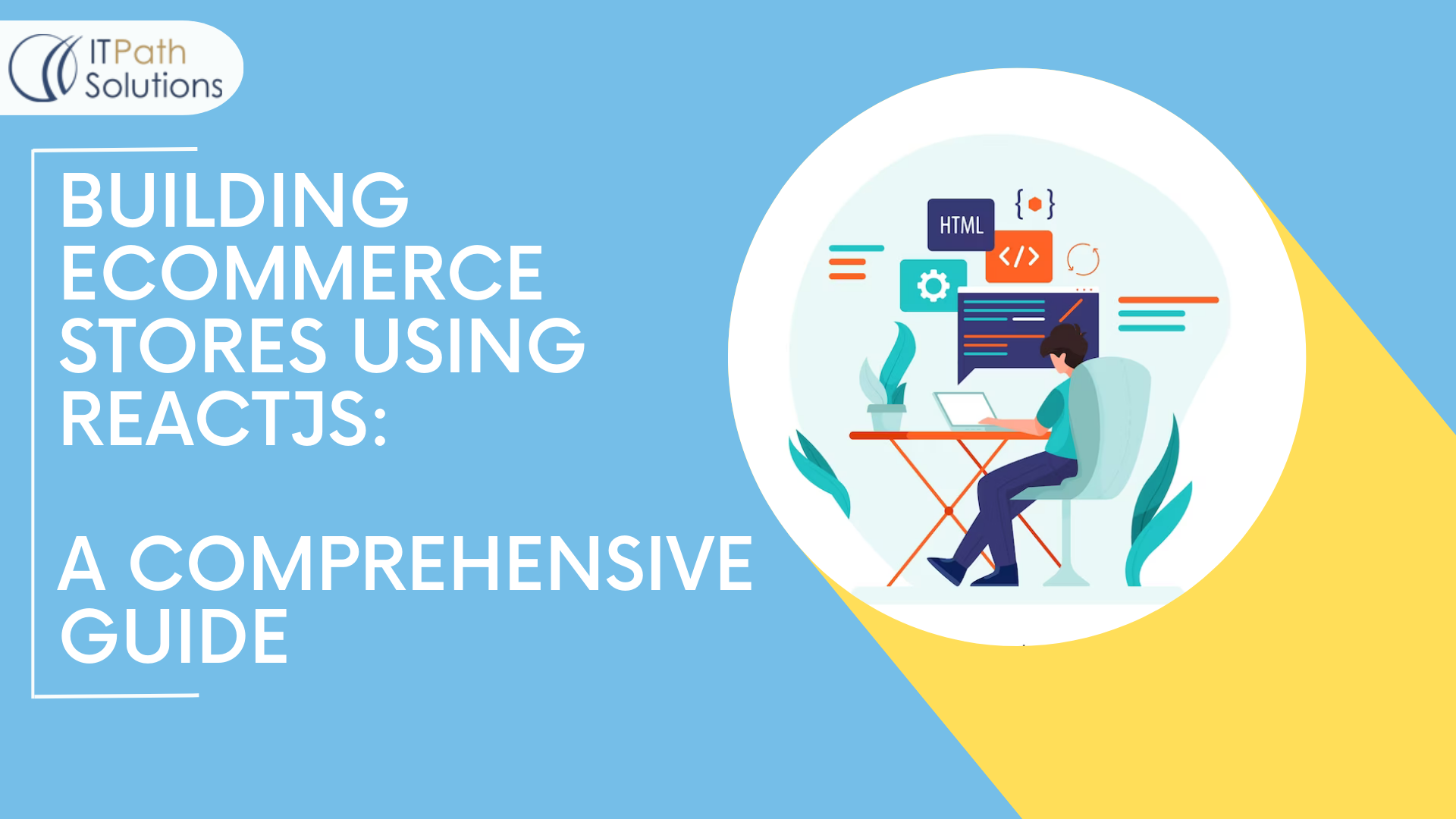Building eCommerce Stores Using ReactJS: A Comprehensive Guide

Introduction: Welcome to our comprehensive guide on creating eCommerce stores using ReactJS. In today’s digital age, eCommerce has become increasingly popular, and choosing the right technology stack is crucial for building successful online stores. ReactJS, with its powerful features and flexibility, offers a robust framework for developing dynamic and interactive user interfaces. In this blog, we will walk you through the process of building an eCommerce store using ReactJS, covering everything from hire Reactjs Developers to setting up the development environment to deploying the final product.
Understanding ReactJS
- Overview of ReactJS and its key features: ReactJS is a JavaScript library for building user interfaces, known for its component-based architecture, performance optimization through virtual DOM, and seamless UI updates. This section will provide an overview of ReactJS and its core features.
- Virtual DOM and its benefits for creating dynamic user interfaces: The virtual DOM is a virtual representation of the actual DOM, which allows ReactJS to efficiently update and render components. This section will explain the concept of the virtual DOM and how it enhances performance in eCommerce applications.
- React components and their role in building reusable UI elements: React components are the building blocks of a React application. This section will delve into the concept of reusable components, their benefits in creating modular UI elements, and best practices for structuring and organizing components.
- React hooks and how they simplify state management and component logic: React hooks are functions that allow functional components to use state and lifecycle methods. This section will introduce popular hooks like useState and useEffect and demonstrate how they simplify state management and component logic in eCommerce applications.
Setting up the Development Environment
- Installing Node.js and npm: To develop a ReactJS eCommerce store, you need to set up the development environment. This section will guide you through the installation process of Node.js and npm, which are essential tools for working with ReactJS.
- Creating a new React project using Create React App: Create React App is a popular tool for bootstrapping React applications. This section will explain how to use Create React App to create a new project, including the necessary commands and directory structure.
- Setting Up the Project Structure and Organizing Files: Proper project structure and organization are essential for maintainability and scalability. This section will cover best practices for structuring React components, assets, and other files in your eCommerce store project.
III. Designing the eCommerce Store Layout
- Planning the Website Structure and Navigation: Before diving into implementation, it’s crucial to plan the structure and navigation of your eCommerce store. This section will guide you through the process of creating a logical website structure and intuitive navigation flow.
- Creating Reusable Components for Header, Footer, and Sidebar: Reusable components enhance consistency and maintainability in your eCommerce store. This section will demonstrate how to create reusable components for common UI elements like the header, footer, and sidebar.
- Building Responsive Layouts Using CSS Frameworks like Bootstrap: Responsive design is vital to ensure a seamless shopping experience across devices. This section will showcase how to leverage CSS frameworks like Bootstrap to create responsive and visually appealing layouts for your eCommerce store.
IV. Managing State and Data
- Introduction to React State and Props: React state and props are fundamental concepts for managing data and passing information between components. This section will provide an introduction to state and props in React and their application in eCommerce stores.
- Implementing A Global State Management System Like Redux or Context API: As an eCommerce store grows, managing state becomes more complex. This section will explore global state management solutions like Redux or Context API and demonstrate their implementation in your ReactJS eCommerce store.
- Fetching and Displaying Product Data From a Backend API: eCommerce stores rely on fetching and displaying product data. This section will guide you through the process of fetching data from a backend API and dynamically rendering it in your React components.
- Implementing Filters and Sorting Options For Product Listings: Offering filtering and sorting options enhances user experience. This section will show you how to implement filters and sorting functionality to help users navigate and find products efficiently.
Building Product Pages
- Creating Reusable Components for Product Cards and Product Details: Product pages are vital for showcasing products. This section will demonstrate how to create reusable components for product cards and product details, allowing for easy customization and management.
- Implementing Dynamic Routing for Individual Product Pages: Each product in your eCommerce store deserves its own page. This section will guide you through implementing dynamic routing using React Router to create unique URLs for individual product pages.
- Adding Features like image galleries, product variations, and reviews: Enhancing product pages with interactive features enriches the user experience. This section will cover adding image galleries, product variations (e.g., colors or sizes), and reviews to provide users with comprehensive information about products.
Implementing Shopping Cart Functionality
- Designing the Shopping Cart Component and Its UI: The shopping cart is a crucial part of any eCommerce store. This section will guide you through designing a visually appealing and user-friendly shopping cart component.
- Managing Cart State and Adding/removing Items: Managing the cart state and allowing users to add or remove items are essential features. This section will cover implementing logic to manage the cart state and handle item additions and removals.
- Implementing Quantity Adjustments and Total Calculations: Providing users with the ability to adjust product quantities and calculating the total cost are important functionalities. This section will demonstrate how to implement quantity adjustments and dynamically calculate the total cost in the shopping cart.
Implementing Checkout and Payment
- Designing the Checkout Page and Forms: The checkout page collects crucial information from users for the purchase process. This section will guide you in designing an intuitive checkout page with forms to capture user details.
- Integrating With A Payment Gateway Using Libraries Like Stripe: A secure and reliable payment gateway is essential for eCommerce stores. This section will demonstrate how to integrate a payment gateway, such as Stripe, to handle secure payment transactions.
- Handling the Order Process and Confirmation: After the payment, order processing and confirmation are necessary to ensure a seamless user experience. This section will cover implementing logic to handle order processing and displaying order confirmation to users.
Adding User Authentication and Account Management
- Implementing User Registration and Login Forms: User authentication allows users to create accounts and access personalized features. This section will guide you through implementing user registration and login forms for your eCommerce store.
- Adding Authentication Using Firebase or a Similar Service: Implementing authentication can be complex. This section will showcase using authentication services like Firebase to handle user authentication securely and efficiently.
- Building User Account Pages and Managing Orders: User account pages provide a centralized location for users to manage their profiles, view order history, and track shipments. This section will demonstrate how to build user account pages and manage orders effectively.
Optimizing Performance and Security
- Implementing Code Splitting and Lazy Loading for Better Performance: Performance optimization is critical for a smooth user experience. This section will guide you through implementing code splitting and lazy loading techniques to improve your eCommerce store’s performance.
- Optimizing Images and Assets for Faster Load Times: Optimizing images and other assets reduces load times and improves overall site performance. This section will cover techniques and tools for optimizing images and assets in your ReactJS eCommerce store.
- Implementing Security Measures Like Input Validation and HTTPS: Security is crucial for eCommerce stores. This section will highlight important security measures, such as input validation, to protect user data and demonstrate the importance of serving your eCommerce store over HTTPS.
Testing and Deployment
- Writing Unit Tests for React Components Using Testing Libraries Like Jest: Testing is crucial to ensure the reliability and stability of your eCommerce store. This section will introduce you to writing unit tests for React components using popular testing libraries like Jest.
- Setting Up Continuous Integration and Deployment (CI/CD) Pipelines: Continuous integration and deployment pipelines automate the process of deploying your eCommerce store. This section will guide you through setting up CI/CD pipelines to streamline your deployment workflow.
- Deploying the eCommerce Store To A Hosting Platform like Netlify or Vercel: Deploying your ReactJS eCommerce store to a hosting platform is the final step before making it available to the public. This section will demonstrate how to deploy your eCommerce store using hosting platforms like Netlify or Vercel.
Conclusion
In conclusion, building an eCommerce store using ReactJS provides a powerful foundation for creating dynamic and user-friendly online shopping experiences. Throughout this guide, we’ve covered essential aspects, from setting up the development environment to deploying the final product. Armed with this knowledge, you’re now equipped to embark on your eCommerce journey using ReactJS. Do drop us aline to discuss your eCommerce idea backed by an NDA.
 Healthcare
Healthcare  Education
Education  Real Estate
Real Estate  Logistic
Logistic  Themes
Themes
 Plugins
Plugins
 Patterns
Patterns





